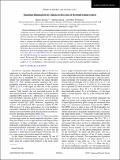Quantum illumination for enhanced detection of Rayleigh-fading targets
Author(s)
Zhuang, Quntao; Zhang, Zheshen; Shapiro, Jeffrey H
DownloadPhysRevA.96.020302.pdf (303.2Kb)
PUBLISHER_POLICY
Publisher Policy
Article is made available in accordance with the publisher's policy and may be subject to US copyright law. Please refer to the publisher's site for terms of use.
Terms of use
Metadata
Show full item recordAbstract
Quantum illumination (QI) is an entanglement-enhanced sensing system whose performance advantage over a comparable classical system survives its usage in an entanglement-breaking scenario plagued by loss and noise. In particular, QI's error-probability exponent for discriminating between equally likely hypotheses of target absence or presence is 6 dB higher than that of the optimum classical system using the same transmitted power. This performance advantage, however, presumes that the target return, when present, has known amplitude and phase, a situation that seldom occurs in light detection and ranging (lidar) applications. At lidar wavelengths, most target surfaces are sufficiently rough that their returns are speckled, i.e., they have Rayleigh-distributed amplitudes and uniformly distributed phases. QI's optical parametric amplifier receiver—which affords a 3 dB better-than-classical error-probability exponent for a return with known amplitude and phase—fails to offer any performance gain for Rayleigh-fading targets. We show that the sum-frequency generation receiver [Zhuang et al., Phys. Rev. Lett. 118, 040801 (2017)]—whose error-probability exponent for a nonfading target achieves QI's full 6 dB advantage over optimum classical operation—outperforms the classical system for Rayleigh-fading targets. In this case, QI's advantage is subexponential: its error probability is lower than the classical system's by a factor of 1/ln(M[ bar over κ]N[subscript S]/N[subscript B]), when M[bar over κ]N[subscript S]/N[subscript B]≫1, with M≫1 being the QI transmitter's time-bandwidth product, N[subscript S]≪1 its brightness, [bar over κ] the target return's average intensity, and N[subscript B] the background light's brightness.
Date issued
2017-08Department
Massachusetts Institute of Technology. Department of Physics; Massachusetts Institute of Technology. Research Laboratory of ElectronicsJournal
Physical Review A
Publisher
American Physical Society
Citation
Zhuang, Quntao, et al. “Quantum Illumination for Enhanced Detection of Rayleigh-Fading Targets.” Physical Review A, vol. 96, no. 2, Aug. 2017. © 2017 American Physical Society
Version: Final published version
ISSN
2469-9926
2469-9934